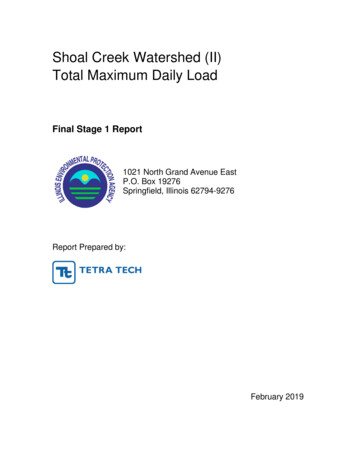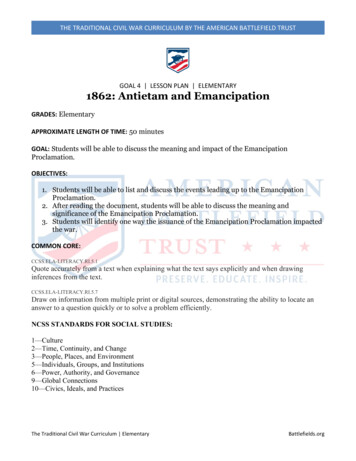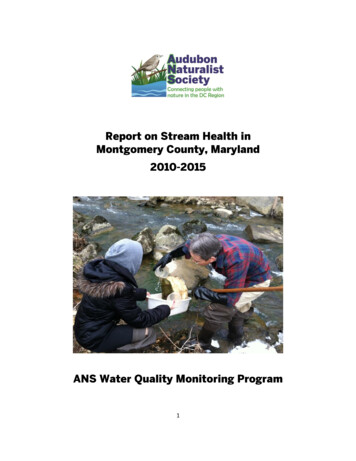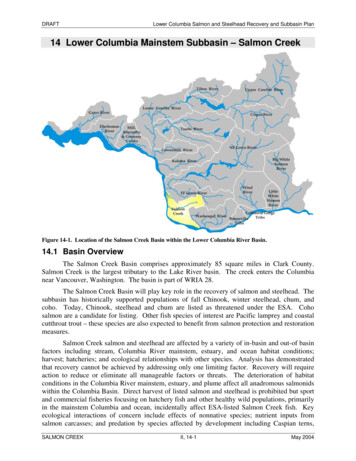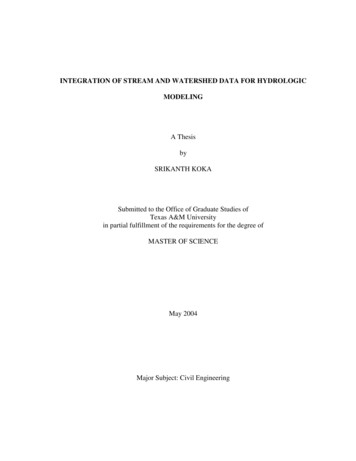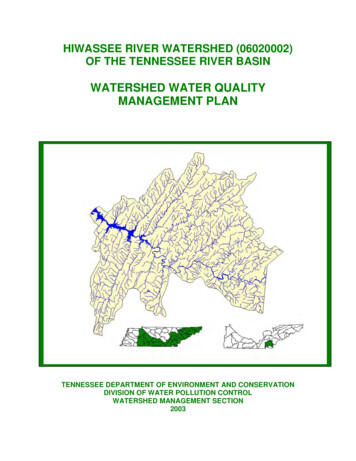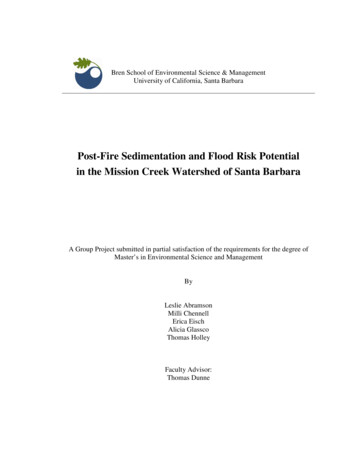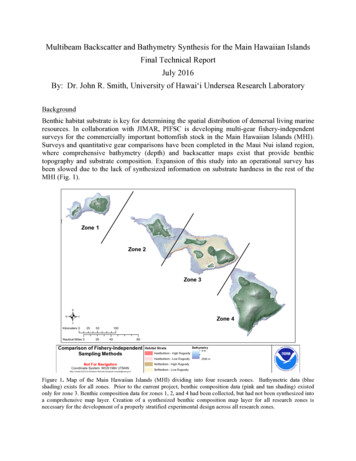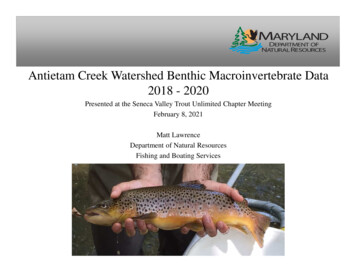
Transcription
Antietam Creek Watershed Benthic Macroinvertebrate Data2018 - 2020Presented at the Seneca Valley Trout Unlimited Chapter MeetingFebruary 8, 2021Matt LawrenceDepartment of Natural ResourcesFishing and Boating Services
Washington County Benthic Sample Collection Locations Benthic macroinvertebrate surveys have beenconducted throughout the Antietam Creekwatershed and in Conococheague Creek. Samples collected from 2018 to 2020. 36 samples collected. This presentation will discuss the results for: Little Antietam Creek Beaver Creek 2020 Beaver Creek trout survey Beaver Creek tributaries
Why the Antietam Creek Watershed? Long history of diverse land use practices. Much effort has been invested intorestoration projects. These efforts have been highly successfuland have resulted in improved water qualityand highly productive fisheries. Community interest continues to driveimproved watershed management.
Benthic Sample Collection Methods Samples are collected using a D frame kick netand three, 30 second kicks. Benthic materials are filtered through a three tiersieve system. All benthic macroinvertebrates are separated fromdebris and placed in containers with isopropylalcohol. Full samples are processed under a dissectingscope. All invertebrates are counted. Benthic invertebrates counts are used to generatemetrics that describe water and habitat quality.
Benthic Macroinvertebrate MetricsRichness and DiversityTaxa Richness Total number of taxa observed in the sample High quality streams tend to have high richness.EPT Richness Total number of taxa observed fromEphemeroptera (mayflies), Plecoptera (stoneflies),and Trichoptera (caddisflies). More taxa indicates a healthy stream.Diversity Index Considers total richness and representation of eachtaxon. Preferred scores are 3.00 or greater. Scores lessthan 1.00 are considered to be severely impaired. Equitability score is based on a predicted diversity.
Benthic Macroinvertebrate MetricsHilsenhoff Biotic Index (HBI) Calculated using tolerance values for each taxon.Tolerance values determined by the MarylandBiological Stream Survey.Scores range from 0 to 10.Lower scores mean less tolerance to habitatdegradation. Sensitive taxa have scores of 3 or less.
Benthic Macroinvertebrate MetricsFunctional Feeding Group Analysis Determined by benthic macroinvertebratefeeding behavior.Based on Vannote’s River ContinuumConcept.Scraper Filterer Ratio Compares total scrapers to total filterers. Scrapers feed primarily on the biofilm ofalgae and bacteria that grows on benthicsubstrates (periphyton). Filterers collect fine particulate organic matterfrom the water column.Proportion of Shredders Proportion of shredders in the sample. Photo credit: USGS Shredders feed on coarse particulate organicmatter (leaf litter).Credit: Vannote et al. 1980
Benthic Macroinvertebrate MetricsColdwater Obligates Two stonefly genera have been identified byMaryland Biological Stream Survey as excellentindicators of coldwater resources.Strong correlation with brook trout.Taxa includes: Roach-like stoneflies (Tallaperla) Green stoneflies (Sweltsa)Credit: D.S. Chandler/discoverlife.orgCredit: D.S. Chandler/discoverlife.org
Little Antietam Creek One of only a few streams that supports wildbrook trout, brown trout, and rainbow trout.Brook trout population inhabits Little AntietamCreek above Route 491.Some habitat related issues have impacted thebrook trout populations, so monitoring isimportant.
Little Antietam Creek
Little Antietam Creek - RichnessPopular Grove Road: Taxa richness 8; EPT taxa 3Upstream of mouth: Taxa richness 21; EPT taxa 6
Little Antietam Creek – Diversity and Equitability
Little Antietam Creek – Dominant TaxaCredit: macroinvertebrates.orgSulphursMidges and Little BWOsNet-spinning caddisfliesCredit: USGSColdwater obligates: Hells Delight Road (Sweltsa) Pleasant Valley Road (Sweltsa and Tallaperla) Route 491 at AT (Sweltsa)Important taxa also included: Blue quills (Paraleptophlebia) Green sedges (Rhyacophila) Golden/Common stoneflies (Acroneuria) Yellow stoneflies (Isoperla; 2017)
Little Antietam Creek – Hilsenhoff Biotic Index HBI scores were 3.15 or less for both samples at the AT and Pleasant Valley Road. The Hells Delight Road score was much higher (4.90). May have been influencedby small sample size.
Little Antietam Creek – Functional Feeding GroupsFunctional feeding group metrics were generally poor. Low scores expected below Route 491. Only 2019 scraper filterer ratio at AT and 2017 proportion ofshredders at Pleasant Valley Road indicate no impairment.LocationScraper Filterer RatioProportion ofShredders2017201920172019--0.67--0.05Pleasant Valley Road0.170.060.450.07Route 491 at AT0.122.130.050.01Poplar Grove Road--0.06--0.07Upstream of mouth*--0.63--0.01Hells Delight Road* 2018
Beaver Creek
Beaver Creek – Sample LocationsStations include: Behind the Fly Shop Mouth of Black Rock Creek Beaver Creek Church Road Behind the Spring House Behind Zimmerman Property Mouth of Beaver Creek (not pictured)
Beaver Creek – RichnessRichness: Average taxa richness from the fly shop to Zimmerman Property was 16.6 (14 - 20). Average EPT richness from the fly shop to Zimmerman Property was 6 (5-7). Taxa richness at the mouth was 18. Diversity and equitability indices support the richness metrics.
Beaver Creek – Dominant TaxaIsopodsLittle BWOsMidgesSulphursCredit: Erin Hayes-PontiusIsopodsCredit: Gail Hampshire
Beaver Creek – Hilsenhoff Biotic IndexUpstream HBI: 4.40 (Very Good).Downstream HBI: 2.89 (Excellent) - high representation of sulphurs (Ephemerella).
Beaver Creek – Historic DataMetric1999 (Average)2018Taxa Richness16 (max 17)20EPT Richness6 (max 9)8Diversity2.542.22Equitability0.510.3Isopods, 46.7%Isopods, 55%HBI4.754.33Scraper filterer ratio0.190.79Proportion of shredders0.130.17Dominant taxaCredit: macroinvertibrates.orgCredit: macroinvertibrates.org
Beaver Creek – 2020 Trout Survey
Beaver Creek Trout Survey – Young-of-YearPut-and-Take4000Abundance 01320142015Year20162017201820192020
Beaver Creek Trout Survey – Young-of-YearCatch-and-ReleaseAbundance 015Year20162017201820192020
Beaver Creek Trout Survey – AdultPut-and-Take400Abundance 15Year20162017201820192020
Beaver Creek Trout Survey – AdultCatch-and-Release120Abundance 62017201820192020
Beaver Creek Trout SurveyAverage Total Biomass kg/HaTop 8 (2015-2019)Beaver CreekMiddle ForkGunpowder Falls - below DamLittle Savage RiverPoplar LickSavage River - below DamKoontz RunSavage River – middleAverage Number of Trout 10 inches/HaTop 8 (2015-2019)Beaver CreekSavage River - below DamHunting Creek - middleSavage River - middleGunpowder Falls - below DamLittle Hunting Creek - middleBee Tree Run - middleHunting Creek - upper
Black Rock Creek – Survey LocationsBenthic samples collected at: Crystal Falls Road (2018 and 2019) Confluence with Beaver Creek (2018) In Sue Rudy Run near Crystal Falls Road (2020)
Black Rock Creek – RichnessExcluding the sample collected in the mainstem at Crystal Falls Road: Taxa richness range: 20 – 24. EPT richness 10 Diversity and equitability indices indicated minimal impairment. Mainstem at Crystal Falls Road showed signs of degradation in 2018, but rebounded in 2019.
Black Rock Creek – Dominant TaxaIsopodsSulphurs and Little BWOsNet-spinning caddisfliesCredit: USGS - NAAMDRCAdditional benthic assemblage information: 9 Tallaperla identified in 2019 Crystal Falls Road sample. No coldwater obligates observed at other stations, but Sue Rudy Run sample included bluequills, green sedges, and Diplectrona.
Black Rock Creek – Hilsenhoff Biotic IndexHBI scores ranged from 5.17 at the mouth of Black Rock Creekto 2.80 (average) at Crystal Falls Road.
Black Rock Creek – Historic DataMetricCredit: USGS - NAAMDRC1999 (avg.)2018Taxa Richness18 (max 20)24EPT Richness7 (max 9)11Diversity2.873.78Equitability0.610.83Isopods, 33%Isopods, 25%HBI3.465.17Scraper filterer ratio2.590.66Proportion of shredders0.120.10Dominant taxaCredit: D.S. Chandler/discoverlife.org
Mount Aetna Creek and Unnamed Tributary at Pondsville RoadCollection locations:UT at Pondsville Road Crystal Falls Road Route 66Mount Aetna Creek UT at Crystal Falls Road Route 66All samples collected in 2018.
Mount Aetna Creek and Unnamed Tributary at Pondsville RoadRichness Richness indicated moderate impairment only at Mount Aetna Creek and Route 66.Diversity and equitability indices suggest minimal impairment at all sites.
Mount Aetna Creek and Unnamed Tributary at Pondsville RoadDominant TaxaMidgesSulphursMidgesBlack FliesCredit: Matt Bertone/NC StateOther important taxa included: Blue quills Yellow stoneflies Golden/Common stoneflies Giant stoneflies Green sedges DiplectronaColdwater obligates: Identified in both upstream stations. UT at Pondsville Road: 4 Sweltsa 2 Tallaperla UT to Mount Aetna Creek 2 Sweltsa 11 Tallaperla
Mount Aetna Creek and Unnamed Tributary at Pondsville RoadHilsenhoff Biotic IndexHBI scores were all 5.38 or less, with upstream scores better than downstream scores. Both samples at Crystal Falls Road had a score of less than 3.00. Both samples collected near Route 66 suggested some impairment, but had a narrative score of“good”.
Mount Aetna Creek and Unnamed Tributary at Pondsville RoadFunctional Feeding GroupsFunctional Feeding Group Metrics All tributary scraper filterer ratios were 1.00 or less but improve downstream. Proportion of shredders was more predictable, with higher representation of shreddersupstream.Scraper FiltererRatioProportion ofShreddersUT to Beaver Creek at Crystal Falls Road0.420.11UT to Beaver Creek at Route 660.750.03UT to Mount Aetna Creek at Crystal Falls Road0.340.31Mount Aetna Creek at Route 661.000.22Beaver Creek - Beaver Creek Church Road0.780.17Beaver Creek – above mouth2.070.00Location
Little Beaver CreekLittle Beaver Creek survey sites. UT to Little Beaver Creek at Crystal Falls Road Little Beaver Creek at Greenbrier Road Little Beaver Creek at Route 66 (2019) Little Beaver Creek at Toms Road.
Little Beaver Creek- RichnessRichness Scores Taxa richness ranged from 22 to 25 (slightly impacted). EPT richness ranged from 7 to 18. Only Route 66 considered to be slightly impacted.
Little Beaver Creek - Dominant TaxaSulphursSulphursNet-spinning caddisfliesNet-spinning caddisfliesSweltsaTallaperlaUT at Crystal Falls Road42Greenbrier Road20Route 6600Toms Road00LocationCredit: USGS - NAAMDRCCredit: USGS - NAAMDRC
Little Beaver Creek – Hilsenhoff Biotic IndexHBI scores were all 5.43 or less. Crystal Falls Road – 3.16 Greenbrier Road – 4.75 Route 66 – 4.70 Toms Road – 5.43
Little Beaver Creek – Functional Feeding GroupsFunctional Feeding Groups Scraper filterer ratio declined at downstream stations. Shredders were under represented at all stations except UT atCrystal Falls Road.LocationScraper Filterer RatioProportion of ShreddersUT at Crystal Falls Road1.800.10Greenbrier Road0.450.03Route 660.230.00Toms Road0.160.00
Thank you
Little Antietam Creek - Functional Feeding Groups Functional feeding group metrics were generally poor. Low scores expected below Route 491. Only 2019 scraper filterer ratio at AT and 2017 proportion of shredders at Pleasant Valley Road indicate no impairment. Location Scraper Filterer Ratio Proportion of Shredders 2017 2019 2017 2019
